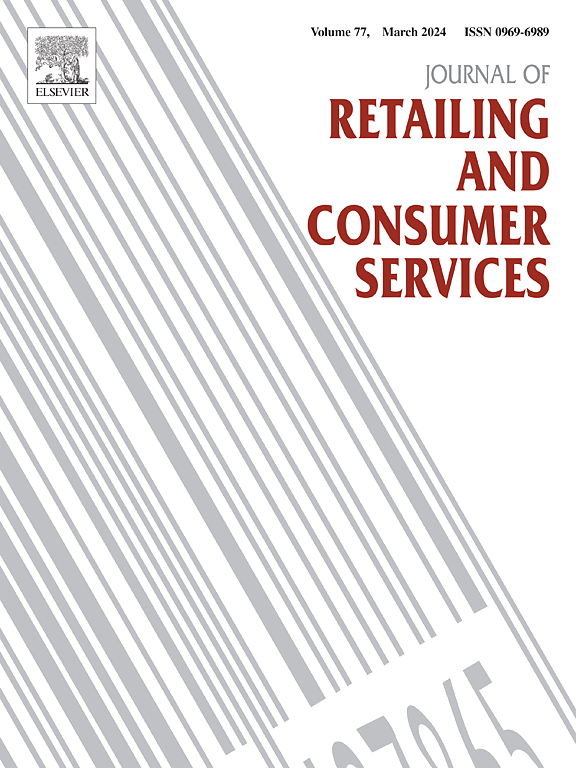The drivers and boundaries of consumer switching from full-length to derivative condensed content
IF 11
1区 管理学
Q1 BUSINESS
Journal of Retailing and Consumer Services
Pub Date : 2025-05-19
DOI:10.1016/j.jretconser.2025.104341
引用次数: 0
Abstract
The widespread adoption of mobile technology has transformed media consumption habits, giving rise to ‘snack culture’ which is characterised by condensed, easily shareable content formats. Although prior research has introduced the concept of snack culture, the consumer shifts from full-length to derivative condensed content remain unexplored. Drawing on the Push-Pull-Mooring framework and Uses and Gratifications theory, this study investigated factors influencing viewers' switching from traditional moviegoing to consuming movie-condensed (recap) videos. PLS-SEM and fsQCA were complementarily used to analyse data from viewers. Results revealed that perceived conciseness, entertainment value, ubiquity, trendiness of movie-condensed videos, and monetary cost of moviegoing significantly drove positive attitudes toward condensed videos, leading to switching behaviour. Additionally, cinephilia was found to weaken the influence of trendiness on attitude, and switching was genre-dependent. From these findings, this study offers three key contributions. First, it advances snack culture literature by demonstrating the psychological mechanisms underlying media format-switching behaviour, showing how pull factors (entertainment, conciseness, ubiquity, trendiness), a push factor (monetary cost), and a mooring factor (cinephilia) drive the transition to condensed content consumption. Second, it extends media competition literature by revealing how derivative condensed content serves both complementary and substitutive roles through its inherent characteristics. Third, it identifies genre-dependent patterns of substitution, establishing content characteristics as a crucial boundary condition for media displacement effects. These insights highlight the need for entertainment producers to adapt their strategies to evolving consumer preferences.
消费者从全长内容转向衍生浓缩内容的驱动因素和边界
移动技术的广泛采用改变了媒体消费习惯,催生了“零食文化”,其特点是内容浓缩、易于分享。虽然先前的研究已经引入了零食文化的概念,但消费者从全长到衍生浓缩内容的转变仍未得到探索。本研究利用推拉系泊框架和使用与满足理论,探讨了影响观众从传统观影转向观影重播的因素。PLS-SEM和fsQCA互补用于分析观众的数据。结果表明,电影浓缩视频的感知简洁性、娱乐价值、普及性、时尚性和观影成本显著推动了人们对电影浓缩视频的积极态度,从而导致了人们的转换行为。此外,研究发现,电影偏好会削弱潮流对态度的影响,并且转换是类型依赖的。根据这些发现,本研究提供了三个关键贡献。首先,它通过展示媒体格式转换行为背后的心理机制来推进零食文化文学,展示了拉动因素(娱乐、简洁性、普遍性、潮流性)、推动因素(货币成本)和系住因素(影迷)如何推动向浓缩内容消费的过渡。其次,通过揭示衍生浓缩内容如何通过其固有特征发挥互补和替代作用,拓展媒介竞争文学。第三,它确定了依赖于类型的替代模式,将内容特征作为媒介替代效应的关键边界条件。这些见解强调了娱乐制作人需要调整策略以适应不断变化的消费者偏好。
本文章由计算机程序翻译,如有差异,请以英文原文为准。
求助全文
约1分钟内获得全文
求助全文
来源期刊
CiteScore
20.40
自引率
14.40%
发文量
340
审稿时长
20 days
期刊介绍:
The Journal of Retailing and Consumer Services is a prominent publication that serves as a platform for international and interdisciplinary research and discussions in the constantly evolving fields of retailing and services studies. With a specific emphasis on consumer behavior and policy and managerial decisions, the journal aims to foster contributions from academics encompassing diverse disciplines. The primary areas covered by the journal are:
Retailing and the sale of goods
The provision of consumer services, including transportation, tourism, and leisure.

 求助内容:
求助内容: 应助结果提醒方式:
应助结果提醒方式:


